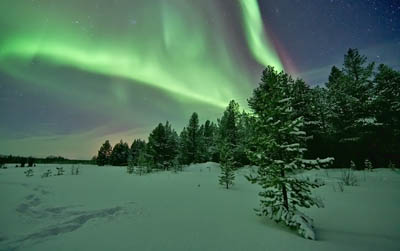Astronomer Philippe Moussette captured the Aurora Borealis in Quebec, Canada in 2004. Image courtesy of NASA
This year we’re in for a cosmic treat in terms of viewing the Aurora Borealis. Because the sun is at its 11-year peak, astronomers are predicting that it will be easier to see the Northern Lights, even here in Ireland.
Stargazers have traditionally descended upon Northern Norway regions such as Troms and Finnmark to observe the Aurora Borealis, but this year Ireland could be in with an even better chance of witnessing the spectacular atmospheric phenomenon because the sun is at the peak of its 11-year solar cycle.
In Ireland our best chance of seeing the Northern Lights appears to be before the spring equinox on 20 March next. It will be easier to see Aurorae the more north you are, plus you need to be away from city lights.
Lighting up the skies
While we associate the Aurora Borealis with winter, they happen all year round. It’s just that they are more easily viewed against a dark sky.
According to Truls Lynne Hansen, an associate professor at Tromsø Geophysical Observatory, University of Tromsø, Norway, they occur most frequently in a 2500 km radius belt that covers the magnetic north pole. He said that this “auroral zone” extends over northern Scandinavia, Iceland, the southern tip of Greenland and continues over northern Canada.
Spaceweather.com has reported that in Finland the Northern Lights are already gleaming.

Andy Keen sent this photo into Spaceweather.com after viewing an Aurora in the municipality of Inari two days ago (16 January). Image courtesy of Andy Keen, www.aurorahunters.com
Andy Keen described to Spaceweather.com: “We didn’t need head-torches on Jan. 16th as the forest was illuminated by the Aurora dancing above our heads. For over two and a half hours we witnessed one of the best light shows that I’ve ever observed in over 5000 hours of ‘chasing’ the auroras. Ribbons, curtains, mini spirals, bursts – you name it and we had it.” Keen added: “If this is a sign of things to come as Solar Maximum approaches, then all I can say is that we’re all in for a real treat over the coming months and years.”
Hansen explained how the Southern Lights signify the corresponding auroral zone around the southern magnetic pole and are mainly seen from Antarctica and the surrounding ocean. He said that the Southern and Northern Lights occur simultaneously and are almost mirror images of each other.